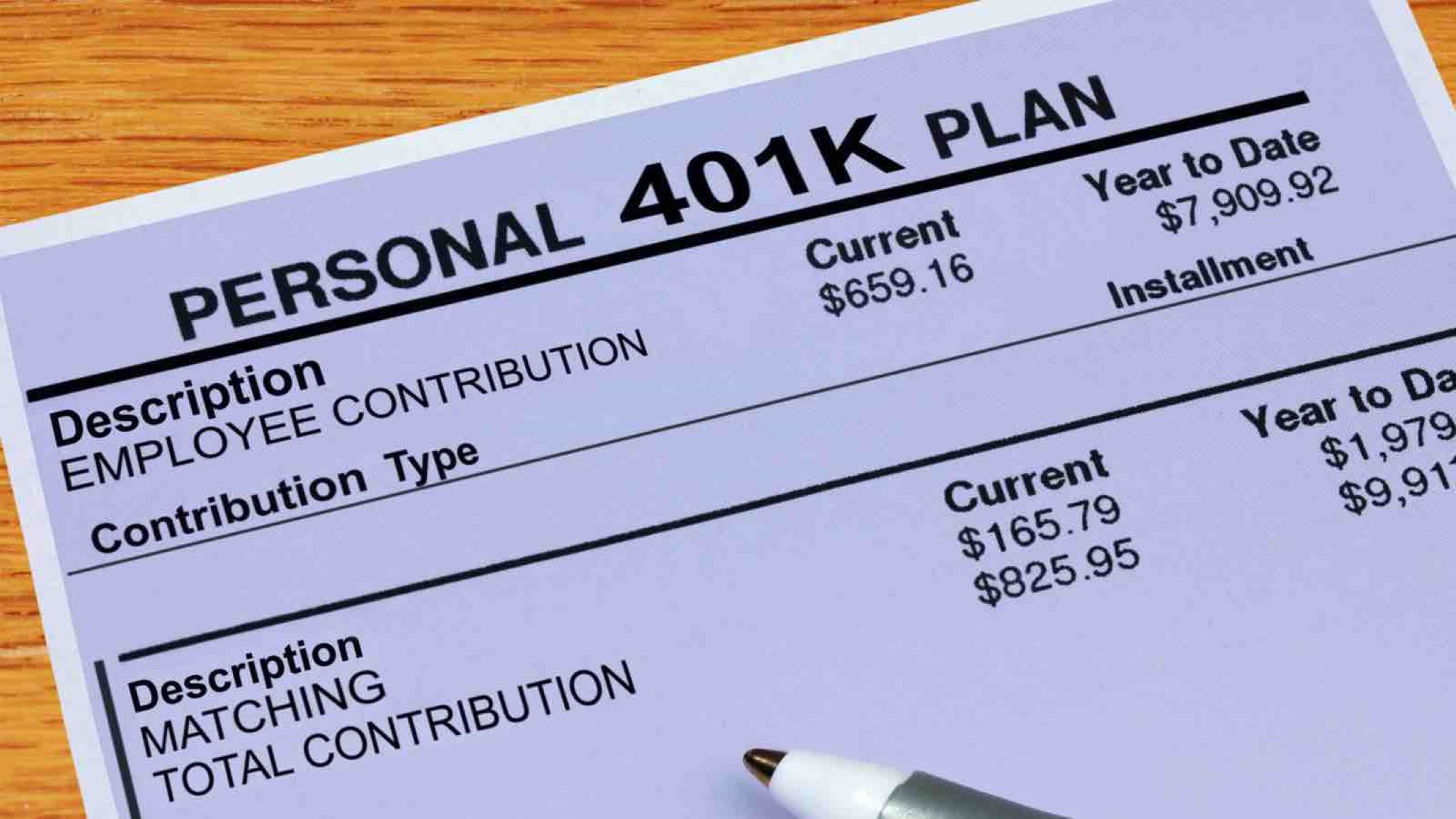Home>Finance>How To Record 401K Employee Contributions Journal Entry


Finance
How To Record 401K Employee Contributions Journal Entry
Modified: December 30, 2023
Learn how to record 401K employee contributions with this comprehensive guide. Simplify your finance journal entry process and ensure accuracy.
(Many of the links in this article redirect to a specific reviewed product. Your purchase of these products through affiliate links helps to generate commission for LiveWell, at no extra cost. Learn more)
Table of Contents
Introduction
Are you an employer or an accounting professional who deals with employee benefits and retirement plans? If so, then understanding how to record 401K employee contributions journal entries is essential to ensure accurate financial reporting. The 401K plan is one of the most popular retirement savings options in the United States, allowing employees to make pre-tax contributions from their salary.
In this article, we will guide you through the process of recording 401K employee contributions journal entries. We will cover the importance of accurately recording these entries, provide a step-by-step guide, and give you an example to help solidify your understanding.
By accurately recording your 401K employee contributions journal entries, you not only ensure compliance with accounting standards, but also maintain accurate financial statements. This is crucial for making informed financial decisions and assessing the overall financial health of your organization.
So, let’s delve into the world of 401K employee contributions and explore how to record journal entries accurately and efficiently.
Understanding 401K Employee Contributions
Before we delve into the process of recording 401K employee contributions journal entries, it’s important to have a clear understanding of what 401K employee contributions are and how they work.
A 401K plan is an employer-sponsored retirement savings plan, commonly offered in the United States. It allows employees to contribute a portion of their pre-tax salary to a designated retirement account. These contributions are deducted from the employee’s paycheck before taxes are withheld, which means that the contributions are made on a tax-deferred basis.
The purpose of 401K employee contributions is to help individuals save for their retirement years. These contributions can be invested in a variety of options, such as mutual funds, stocks, bonds, and other investment vehicles, allowing the funds to grow over time. Additionally, many employers offer matching contributions, where they will match a portion of the employee’s contributions, further enhancing the growth potential of the account.
It’s important to note that there are annual contribution limits set by the Internal Revenue Service (IRS) for 401K plans. As of 2021, the maximum contribution limit is $19,500 for individuals under the age of 50. For individuals aged 50 and over, an additional catch-up contribution of $6,500 is allowed, bringing the total maximum contribution to $26,000. These limits are subject to change, so it’s crucial to stay updated with the latest regulations.
Now that we have a clear understanding of 401K employee contributions, let’s move on to why accurately recording journal entries for these contributions is vital for financial reporting and compliance purposes.
Importance of Recording Journal Entries
Accurately recording journal entries for 401K employee contributions is crucial for several reasons. Let’s explore why it’s important to maintain proper documentation of these transactions:
- Compliance: Following accounting standards and regulations is vital for any business. Recording journal entries for 401K employee contributions ensures compliance with accounting principles, such as the Generally Accepted Accounting Principles (GAAP). By adhering to these standards, you demonstrate transparency and accuracy in your financial reporting.
- Financial Reporting: Recording journal entries for 401K employee contributions allows for accurate financial reporting. These contributions impact your company’s financial statements, including the balance sheet and income statement. Proper documentation ensures that the financial statements reflect the true state of your company’s finances, which is important for decision making, attracting investors, and meeting regulatory requirements.
- Audit Readiness: Maintaining organized and accurate records of 401K employee contributions makes the auditing process smoother. When auditors review your financial statements, they will examine the journal entries related to employee contributions. Having well-documented journal entries ensures that the audit process proceeds efficiently and eliminates any potential discrepancies or errors.
- Tax Compliance: Properly recorded journal entries for 401K employee contributions are essential for tax compliance purposes. These contributions have implications for both the employer and employees when it comes to taxes. Accurate documentation ensures that the correct tax treatment is applied, reducing the risk of penalties or audits related to tax compliance.
- Employee Trust and Transparency: Accurate recording of 401K employee contributions through journal entries fosters trust and transparency among employees. These contributions are a crucial part of their retirement savings, and they need assurance that their funds are being handled properly. By maintaining organized records, you demonstrate your commitment to their financial security, which can enhance employee morale and loyalty.
Now that we understand the importance of recording journal entries, let’s move on to a step-by-step guide on how to do it correctly.
Step-by-Step Guide to Recording 401K Employee Contributions Journal Entry
Recording 401K employee contributions journal entries may seem daunting, but by following these steps, you can ensure accuracy and efficiency:
- Identify the Contribution Amount: Determine the total contribution amount made by the employee for the designated period. This information can typically be obtained from payroll records or through communication from the employee or their financial institution.
- Create a New Journal Entry: Open your accounting software or ledger and create a new journal entry specifically for 401K employee contributions.
- Debit the 401K Expense Account: Debit the 401K expense account for the total contribution amount. This account is typically classified as an employee benefit expense and is used to track the company’s contributions towards employee 401K plans.
- Credit the Employee 401K Contribution Account: Credit the employee 401K contribution account for the same amount. This account represents the individual employee’s contributions and tracks their retirement savings balance.
- Record the Date: Include the date of the journal entry to accurately reflect the contribution period.
- Add Descriptions or Notes: Provide any relevant descriptions or notes to provide additional context or details regarding the journal entry, such as the employee’s name and the payroll period.
- Save and Review: Save the journal entry and review it for accuracy. Double-check that the debit and credit amounts match and that all relevant information is included.
- Post the Journal Entry: Once you are satisfied with the accuracy of the journal entry, post it to the general ledger or accounting system, ensuring that it is properly recorded and reflected in the company’s financial records.
Following these steps will help you accurately record journal entries for 401K employee contributions, ensuring a clear and transparent record of these transactions.
Now, let’s move on to an example to further solidify your understanding.
Example of a 401K Employee Contributions Journal Entry
Let’s walk through an example to illustrate how a 401K employee contributions journal entry is recorded:
Assume that for the month of September, an employee named John Smith made a 401K contribution of $500. The company has set up a 401K expense account to track their contributions, and each employee has an individual 401K contribution account.
To record this journal entry:
- Debit the 401K Expense Account: Debit the 401K expense account for $500 to reflect the company’s contribution. This increases the expense incurred by the company for providing employee benefits.
- Credit the Employee’s 401K Contribution Account: Credit John Smith’s 401K contribution account for $500. This increases his individual retirement savings balance.
The resulting journal entry would look as follows:
| Date | Account | Debit ($) | Credit ($) |
|---|---|---|---|
| September 1, 20XX | 401K Expense Account | 500 | |
| September 1, 20XX | John Smith’s 401K Contribution Account | 500 |
In this example, the company’s 401K expense account is debited by $500, reflecting the expense incurred for John Smith’s contribution. Simultaneously, John Smith’s 401K contribution account is credited with $500, representing his individual contribution.
By accurately recording this journal entry, the company’s financial statements will reflect the contribution made by John Smith towards his 401K plan and the corresponding expense incurred by the company.
Remember, the specific accounts used and the amounts recorded may vary based on your company’s chart of accounts and accounting system. It’s important to consult with your accounting team or refer to your company’s specific guidelines when recording journal entries.
Now that we have seen an example, let’s wrap up this article by summarizing the key points we have covered.
Conclusion
Accurately recording 401K employee contributions journal entries is essential for maintaining proper financial reporting, compliance, and transparency. By following the step-by-step guide outlined in this article, you can ensure that your journal entries accurately reflect the employee contributions and their impact on the company’s financial statements.
We discussed the importance of accurately recording these journal entries, including ensuring compliance with accounting standards, facilitating financial reporting and audits, maintaining tax compliance, and fostering trust and transparency among employees.
Understanding the basics of 401K employee contributions, such as the purpose of the contributions and the annual contribution limits, is crucial for accurately recording the journal entries. Additionally, we provided an example to visualize how a journal entry for 401K employee contributions would look in practice.
Remember, maintaining organized and accurate records is key. Double-checking your journal entries for completeness and accuracy before posting them will help avoid any errors or discrepancies that could impact the integrity of your financial statements.
By following the guidelines outlined in this article, you can ensure that your company remains compliant, maintains accurate financial records, and provides employees with a transparent view of their 401K contributions.
Now, armed with this knowledge and understanding, you can confidently navigate the world of recording 401K employee contributions journal entries. As always, consult with your accounting team or financial advisor for specific guidance tailored to your organization’s unique circumstances.
So, go ahead, record those journal entries accurately, and contribute to the financial success and retirement security of your employees!














